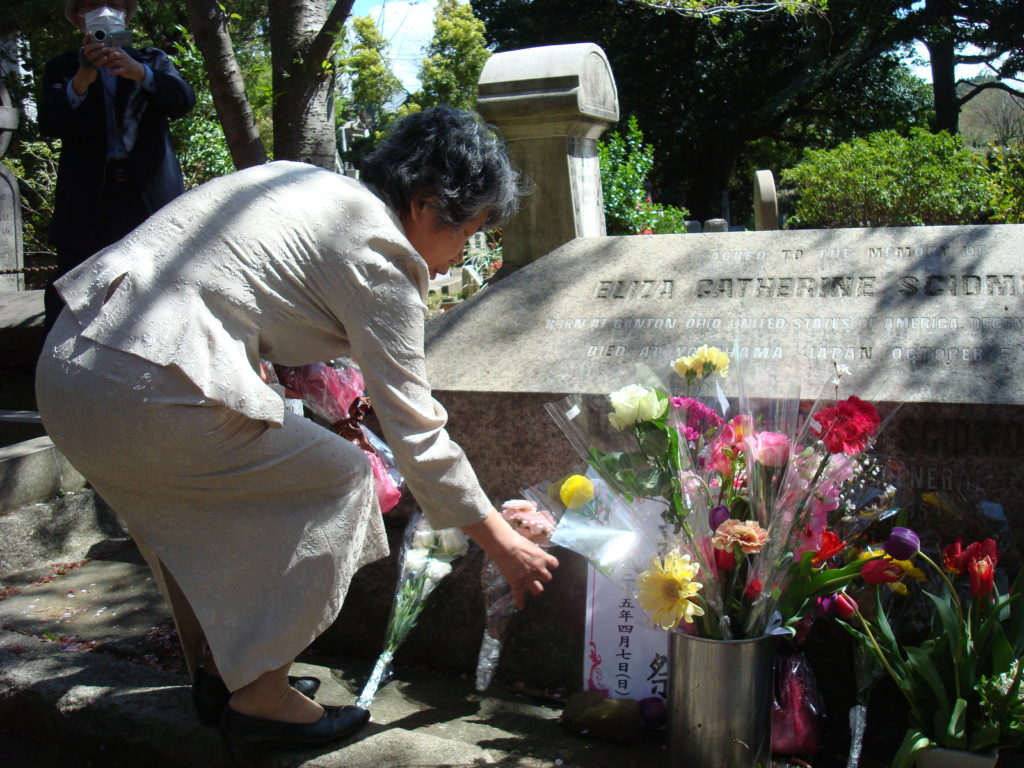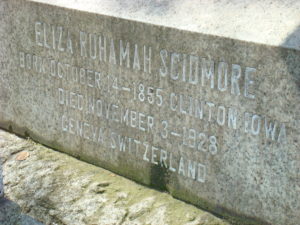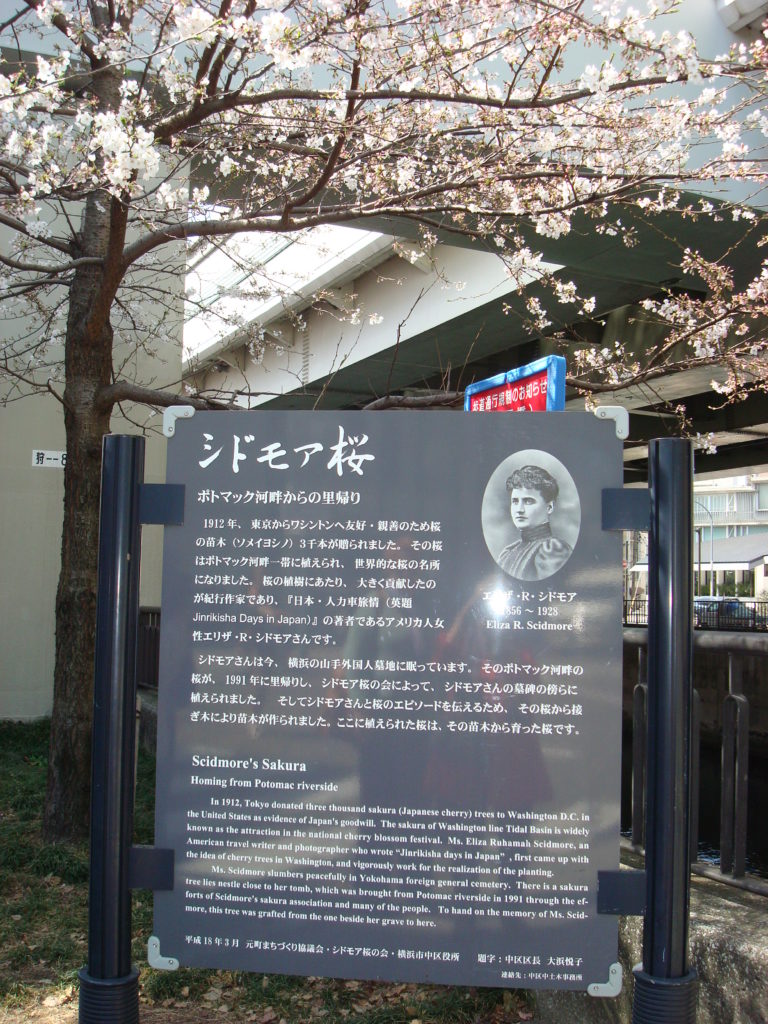Group in Japan Keeps Scidmore Memory Alive
When I started this blog a year ago (in an earlier version, titled A Great Blooming), my first post showed a photo of Eliza Scidmore‘s grave in Yokohama. A Japanese friend of mine in America, Miho Kinnas, sent the picture after visiting the site on a trip to Japan.
Scidmore is buried in the Foreign General Cemetery, in the Yamate area of Yokohama.
I got the photo from Miho soon after starting work on a biography of Scidmore. I knew I’d have to visit Japan (for the first time) to do research and visit Scimdore’s grave.
Today, I joined members of the Eliza Scidmore Cherry Blossom Society (Sakura-no-Kai) for a memorial service at her grave.
The leafy neighborhood of Yamate— known as “the Bluff” in Scidmore’s day — sits high on a cliff, overlooking Yokohama’s busy harbor. The Bluff was a favorite residential neighborhood of diplomats and other Westerners working in Japan.

Kaoru Onji at the grave site site of Eliza Scidmore and her brother and mother at the Foreign General Cemetery, in Yokohama (Photo by Diana Parsell)
‘Jinrikisha Days in Japan’
Kaoru Onji, a retired professor of organic chemistry, organizes the activities of the Eliza Scidmore Society. Mina Ozawa, director of the Yamate Museum, assists her.
The Society grew from a handful of people who shared an interest in Eliza Scidmore after her book Jinrikisha Days in Japan first appeared in Japanese translation, about 25 years ago. In 1987, a small group visited her grave site.
Since then, visiting her grave during cherry blossom season has become a tradition. Today the group has about 50 members.
This year I attended the memorial with three dozen members of the Eliza Scidmore Society and their guests, on a spring day buffeted by fierce winds.

The cherry tree overhanging Eliza’s grave site is a scion of one of the first trees sent to Washington. (Photo: Diana Parsell)
Eliza shares a headstone with her mother and her brother George, a longtime diplomat in Japan. The headstone — flat and rectangular with a peaked “roof” — was originally installed for Eliza’s mother, who lived in Yokohama and died there in 1916. Her name, Eliza Catherine Scidmore, is most prominent.
A majestic cherry trees hovers above the Scidmores’ grave site. The Eliza Scidmore Society planted it in 1991 as a sapling descended from one of the 3,000 trees that Japan donated to Washington a century ago. About half of those trees formed the original ring of cherry trees surrounding the Tidal Basin in Washington.
“Eliza’s tree” at the grave site in Yokohama has a canopy that spreads about 35 feet. Because the blooming season here in Japan occurred two weeks earlier than expected, the tree had already peaked by the time of the memorial service. Fortunately, I visited the cemetery soon after I arrived in Yokohama, so I got to see the tree in its full glory.
It’s nice to think that the petals fall on Eliza Sidmore’s place of rest.
After the brief graveside service, we all retreated to a local restaurant for a buffet luncheon. I shared some of my research findings with the group.
‘A Woman Who Loved Cherry Blossoms’
 Eliza Scidmore was living in Geneva, Switzerland, when she died in the fall of 1928, after an emergency appendectomy.
Eliza Scidmore was living in Geneva, Switzerland, when she died in the fall of 1928, after an emergency appendectomy.
She had left instructions in her will that she wanted no memorial or any special dispensation of her ashes. Good friends — American and Japanese — disregarded the directives. They held a memorial service in Geneva and arranged for the ashes to be buried at the cemetery in Yokohama.
With Mrs. Scidmore’s name engraved on top and George’s on the long side panel, Eliza’s name was added at one end. The Eliza Scidmore Society installed a small plaque nearby. It says, in Japanese: “A woman who loved cherry blossoms rests here in peace.”
The Foreign General Cemetery has about 4,200 graves, many dating from Yokohama’s early growth as a major port city.
As Japan underwent rapid modernization in the Meiji era, the government hired several thousand foreigners as teachers and technical advisers. Some stayed permanently in Japan and are buried here. Others include sailors, missionaries, businessmen and many victims of the Great Kanto Earthquake of 1923 that leveled much of Yokohama.
The Eliza Scidimore Society also installed an informational panel about Eliza at the foot of the hill. Next to it is another cherry tree, a third-generation descendant of one of the first cherry trees in Washington.

So interesting! Thanks for sharing.
My daughter has a copy of “As the Hague Ordains” published by H. Holt in 1899. We can’t find this particular edition at any bookseller online.
Do you have any info about this book?
Anne. This publication date doesn’t sound right, as the book “As the Hague Ordains” was published in 1907. It was based on Eliza Scidmore’s experience in Japan during the Russo-Japanese War in 1904-5, so an earlier publication date doesn’t seem possible.
I agree that it doesn’t “seem” possible. Yet, the book my daughter has shows an 1899 publication date. It has no sub-title like the 1907 edition and no author’s name. Contents, however, are exactly the same as the 1907 edition. It is a real puzzle to us.
After posting above, I examined the book my daughter has. I think the 1899 date refers to the Hague Convention date, not the publication date. It appears to have no publication date, which seems very strange. It also has no info re “first edition”, “nth printing” or anything else. I wonder if maybe a few pages before the Table of Contents are missing. It looks like a very old book. Anyway, thank you for your reply to my first post.
Ann. I checked my copy, and I think your guess is right, that some early pages are missing. I’m seeing a page that says in tiny print “The Hague 1899” and gives “customs of war” statement, which of course is the subject of the book. Interestingly, my edition is from 1914, when the copyright was transferred to The Century Co. Instead of being anonymous, as in the 1907 edition, Eliza Scidmore is identified as the author, and she even includes a preface describing how she came to write the book.
Dear Diana,
I am introduced your name and your project about Eliza Scidmore by Ms.Onji of Eliza Scidmore Cherry Blossom Society (Sakura-no-Kai). I attended annual memorial service at her grave on last Saturday (April 5th). I have reached to your homepage and blog now. It is mauch delighted to know that someone is working on Eliza Scidmore this level of intensiveness! I am very much interested to know when upcoming publishment of the biography is expected.
Eliza’s love and enthusiasm about Sakura is amazing. Indeed she deserves more praise and spotlighted attention from more people. I wish your current work about her biography contributes the purpose and I believe that will happen for sure.
Sincerely,
from one of Sakura freak (almost obsessed!) person in Japan
April 9, 2014
Hiromichi Kurata
Suzuka, Mie Japan
What an honor for Eliza.
Yes, it’s remarkable the dedication to her legacy in Japan, where she’s more well known than in her native America. Many people I met during a research trip to Japan had passing knowledge of her.
Ms Skidmore’s “Jinrikisha days in Japan” 1891 is as interesting if not more interesting than Lafcadio Hearn’s “Writings from Japan” beginning 1890. Very fascinating with remarkable and detailed descriptions.
Ms Skidmore certainly had an eye and pen for everything Japanese!